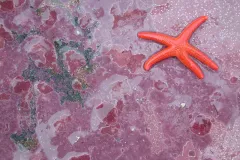Microbes Help Corals Pick a Home and Settle Down

Bacteria are everywhere in the ocean. They live in the water, on virtually every living and non-living surface, and even inside other organisms. There are 1 million bacterial cells in every milliliter of seawater; that translates to roughly 5 million bacterial cells per teaspoon! With so many bacteria in the ocean you have to wonder—what are they doing?
Thanks to new technological advances, we understand more and more about the important roles that bacteria play in the health and ecological interactions of marine organisms. One of their most important roles is in the production of a wide array of chemical compounds. Chemicals drifting in the water are like smells to us. Just like the smell of cookies in the oven draws us into the kitchen, bacteria will release chemicals that signal to other organisms that there is good food around. Just like the smell of garbage or waste makes us want to run the other way, some bacterial chemicals warn other organisms to stay away. Some of these bacteria-made chemicals can travel very far in the water, while others stay close to the bacteria and can only be sensed up close.
Bacteria and their chemical “scents” play critical roles on coral reefs by producing chemical cues that tell corals where to find a home. Adult corals can’t move around. Instead, their home is chosen when they are young larvae swimming around in search of a good place to settle down. When they find the right spot, they attach themselves to the surface, undergo metamorphosis and start growing. Once a larva has attached to a spot, it can’t move to a new location. So it is important to choose a safe place that is conducive to a long life.
Over the past few years we have been trying to figure out how coral larvae make this important decision. We knew that some corals preferred to settle on a certain type of algae called crustose coralline algae. This algae looks like pink paint and covers many surfaces on coral reefs. Some corals can distinguish between different species of crustose coralline algae, but scientists don’t really understand how. As a microbiologist and a chemist, I started thinking about the possibility that bacteria could be producing chemical signals that the corals were using to find their future home. I started looking at the bacteria living on the surface of crustose coralline algae and found that different species have different bacteria living on their surfaces. Could the coral choose its home based on the bacteria that were living there?
Using the mustard-hill coral Porites astreoides, we tested the idea that coral larvae would settle in response to bacterial biofilms, slimy mixtures of bacteria that form on the surfaces of pretty much anything under the sea. We placed tiles on the reef so that bacteria and biofilms would begin to grow on their surfaces. We found that the longer we left the tiles on the reef, the more larvae would settle on them. Then when we removed the bacteria from the tiles by treating them with antibiotics, the larvae would no longer settle on the tiles.
This experiment showed that the corals were definitely responding to the presence of bacteria on the tiles. But we also wanted to know if only specific bacteria caused them to settle, or if any type of bacteria did the trick. To see if the larvae were responding to specific bacteria, we isolated bacterial strains from multiple species of crustose coralline algae and tested them individually. To our surprise, the larvae only settled in response to one out of 16 strains tested. Not only did the coral larvae require bacteria to locate a place to settle, they could recognize specific species of bacteria!
The next step was to figure out how the coral larvae could sense the bacteria. It turns out the larvae could “smell” the bacteria. The bacteria produce a specific chemical called tetrabromopyrrole (TBP) that the larvae can detect as they swim near. Once they reach a crustose coralline alga covered with the right bacteria, they settle there. Besides the mustard-hill coral, TBP also causes settlement in larvae of the boulder-star coral (Orbicella franksi) and the threatened elkhorn coral (Acropora palmata).
We are continuing to work to understand the role that bacteria and the compounds they produce play in helping corals find a safe home on the reef. Based on these laboratory experiments, it appears that this compound could be important in helping the larvae of many different species of corals locate a place to settle down where they will have the greatest chance for survival. Why they all prefer the smell of one type of bacteria remains a mystery that is keeping us busy.
So when you think about the health of coral reefs, remember: it’s sometimes the things you can’t see that are the most important.
Editor's Note: Jennifer wrote this blog post about her new scientific paper that just came out in the Proceedings of the Royal Society B. Read it here.


